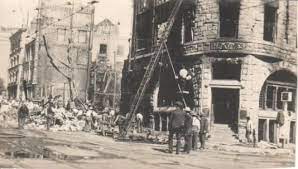On October 1, 1910, the United States witnessed one of the most significant events in its media history - the bombing of the Los Angeles Times building. This tragic incident, known as the "Los Angeles Times bombing," resulted in the loss of lives and highlighted the tensions between labor unions and powerful business interests during the early 20th century. At the time of the bombing, the Los Angeles Times was a prominent newspaper owned by Harrison Gray Otis, a powerful figure in the city's business and political circles. The newspaper had a reputation for its anti-union stance and its support for conservative causes. The bombing was carried out by two union members, James B. McNamara and his brother John J. McNamara, who were associated with the International Association of Bridge and Structural Iron Workers. The motive behind the bombing was believed to be retaliation against the Los Angeles Times for its strong opposition to labor unions and its alleged mistreatment of workers. The explosion occurred in the early morning hours of October 1, 1910, when a suitcase filled with dynamite was detonated in the alley behind the Los Angeles Times building. The blast was powerful and caused extensive damage to the building, resulting in the collapse of a portion of the structure. In addition to the physical damage, the explosion caused a fire that further engulfed the building. Tragically, the bombing resulted in the deaths of 21 people and injured many others. The victims included newspaper employees who were working inside the building at the time of the explosion, as well as bystanders who were passing by the area. The attack shocked the nation and generated widespread outrage and condemnation. The aftermath of the Los Angeles Times bombing led to a significant investigation and subsequent trials. James B. McNamara was arrested and eventually pleaded guilty to the bombing, while his brother John J. McNamara was apprehended later and stood trial. The incident shed light on the tensions between labor unions and powerful business interests, and it became a focal point for debates on workers' rights, the role of unions, and the influence of the press. The Los Angeles Times bombing had a lasting impact on both the city and the nation. It influenced public opinion and attitudes towards labor unions, prompting a reevaluation of the treatment of workers and the need for improved labor conditions. The incident also highlighted the power of the press and the responsibility of media organizations to provide fair and unbiased coverage. In the years following the bombing, the Los Angeles Times continued to operate and eventually became one of the largest and most influential newspapers in the country. The tragedy served as a reminder of the importance of a free press and the need for responsible journalism in a democratic society. Today, the events of October 1, 1910, are remembered as a significant moment in U.S. media history. The Los Angeles Times bombing stands as a stark reminder of the struggles and conflicts that have shaped labor relations and the role of the media in American society. It serves as a testament to the ongoing quest for a balance between the rights of workers, the power of the press, and the pursuit of justice and equality.
1 Oct, 1910 U.S.A. Los Angeles Times
